Does your dog understand what behavior you wish her to perform when you use verbal cues alone, with absolutely no hand gestures or suggestive body language? In many cases, the body-language picture we present to our dogs tells them as much – or more – about what we expect them to do as our verbal cues do.
In fact, it’s pretty common for dogs to be unable to perform the behavior that their owners are sure they know upon hearing the verbal cue alone – for example, if the owner’s back is turned to the dog when he gives his dog the verbal cue.
There are many compelling reasons to strengthen our dogs’ knowledge of and response to verbal cues – not least of which is that there are actually times when it would be helpful for our dogs to perform the behaviors we want when our back is literally turned!
The stronger their understanding of and response to our verbal cues, the more likely it is for our dogs to respond to those cues in situations where we look different, such as when our hands are full, we are sitting down, we are keeping our eyes on an approaching dog and/or person, or when our dog can’t see us because he’s darting toward the delivery van pulling in the driveway.
How to Teach a Verbal Cue
By helping your dog make an association between your verbal cue, the desired behavior, and the delivery of a resulting reinforcer (such as a food treat), you teach your dog how to respond with the appropriate behavior when you ask for it. You are giving him a choice: the opportunity to be reinforced for performing a particular behavior, or not. If he chooses “not,” then your job is to figure out how to help him want to choose to do the behavior.
First, you will properly introduce the cue and help him understand what it means. While there are several different ways to do this, we’ll walk you through the process with a couple of basic behaviors using one of our favorite training techniques: the lure-reward method. The steps are:
1. Get the behavior. Encourage the dog to do the behavior by using a treat as a lure to explain to him what you want. When he does the behavior for the lure, “mark” the moment that he does the desired behavior (with the click of a clicker or a verbal marker, such as the word “Yes!”) and give him a treat. (Note: For some dogs and/or for some behaviors, you may need to lure/shape – marking and giving treats for pieces of the behavior until you build the final behavior. See “Shaping Your Dog’s Behavior,” WDJ January 2017.)
2. Add the cue. When your dog will easily offer the behavior for the lure, use your verbal cue just prior to luring the behavior. You are essentially explaining to him, “This word means the same thing as this luring motion I’ve been doing.” Continue to mark and treat as appropriate throughout the process.
Your dog training reward marker doesn’t need to “click”
A clicker is a small device that makes a consistent, distinct clicking sound. Some make a very sharp sound; some make a softer (though still consistent) clicking sound, like the sound of a ballpoint pen being retracted or extended with the press of a button. But markers don’t have to be a click; any distinctive, consistent sound, gesture, or event can work.
I sometimes use the verbal marker “Yes!” with dogs, in a distinct, consistent, bright tone of voice. I have also perfected a loud “mouth click” by suctioning my tongue to the roof of my mouth and pulling it off with a resounding “pop” – very useful when working with horses and I want both of my hands free to handle a 1,000-pound animal and related equipment. Dogs who are sound-sensitive may do better with a verbal marker than a plastic clicker.
But the marker doesn’t have to be a sound! People who train deaf dogs often use a thumbs-up gesture or a momentary flash of a small flashlight to mark the desired behavior displayed by their canine students. Any signal that is consistent and easily noticed can work as a reward marker.
3. Add a pause. After several repetitions, pause for a few seconds after you say the cue, to give his brain a chance to process the word; then lure the behavior. (“Several” will vary from dog to dog. Some dogs will get it quickly; some dogs need more repetitions to understand the process. You will come to know how many repetitions is appropriate for your dog.)
4. Vary the pause. As you proceed with cue-pause-lure, begin to vary how long you wait before you lure. Sometimes, use the lure after just a second or two; sometimes wait several seconds. Luring quickly keeps him from getting frustrated. Waiting longer before you lure gives him more time to think.
5. Reinforce offered behaviors. At this point, some dogs will begin to offer the behavior before you lure. If yours does, the first time he does it, mark, treat, and party! Tell your dog how brilliant he is, give him several treats (or a special high-value treat you’ve saved for this occasion), and give him a break before you try again. Know that just because he did it once doesn’t mean he will do it every time – you may still have to do some cue-pause-lure repetitions, but it means you are well on the way to getting the behavior “on cue.” Congratulations!
6. Fade the lure. Some dogs won’t begin to offer the behavior so easily, which means you will need to “fade” the lure. This means you will continue to cue-pause-lure, but gradually decrease the amount of luring help you give him.
For example, if you were moving the lure six inches, try moving it just four inches; if he commits to finishing the behavior, whisk the lure away, mark the completion of the behavior without the treat in front of his nose, then give him the treat.
Also, be conscious at this stage that you do not inadvertently use other body-language hints or “prompts” to help your dog do the behavior, such as moving a hand toward the floor for the “down.” If you do use these prompts, you will have to fade them later to have the behavior truly on verbal cue alone.
Continue with your repetitions, fading the treat more and more, until your dog will reliably offer the behavior without the lure. Congratulations!
Note: Notice that I do not use “air cookies” – pretending to lure but not actually having a treat in your hand. To me, this is lying to your dog, and you still have to fade the “air cookie.” You might as well just skip this extra step and move right to fading the lure.
Verbal Cue for “Sit”
Sitting is one the most basic of canine behaviors. It’s an easy behavior for most dogs to do, and a great “incompatible behavior” to ask for when you don’t want your dog doing something else, such as jumping up on people. It also can become a useful “default” behavior – the behavior you teach your dog to offer when he’s not sure what else to do, or when he’s asking for something – like, your attention or his dinner.
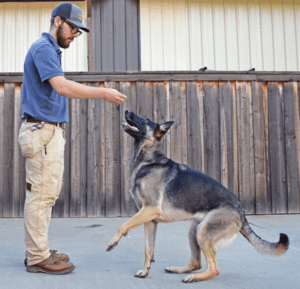
Here’s how to teach your dog a verbal “Sit” cue using this process.
1. Get the behavior. Do not use your verbal “Sit” cue for this step. Simply use a food lure to encourage your dog to sit, by placing it at the tip of his nose and slowly lifting up a little. (If you go too fast you will “outrun” him and he will lose his connection to the lure.)
With some dogs you can move the treat back over the head a little; other dogs will find this aversive and back away from you. Experiment a little by moving the lure in different places – back a little, forward a little, up a little more, up toward your chest – until you find the place that invites him to sit.
If he doesn’t lure into a sit fairly easily, lure/shape it by marking and giving him a treat him for any upward head movement that follows the treat, and for any lowering of the hindquarters, until he is all the way in a sitting position.
2. Add the cue. When your dog will sit easily for the lure, it’s time to add the cue. Say “Sit!” in a cheerful tone of voice (remember, it’s an invitation, not a command!), and lure him into a sit position. Repeat this at least a half-dozen times. Continue to mark (with the click of a clicker or a verbal marker, such as the word “Yes!”) and give him a treat for sits throughout the process.
3. Add a pause. Now say “Sit” in a happy voice and pause a few seconds. If he sits, mark and treat and party – you have a canine genius! More likely he won’t sit for just the cue yet, so after two to three seconds, lure him to sit, then mark and treat. Repeat several times.
Cue the cues
Today’s force-free dog training professionals increasingly use the word “cue” rather than “command” to describe the communications we give to our dogs when we want them to perform a behavior. Here’s why:
The word “cue” typically refers to a signal that encourages someone to take an action. A cue informs your dog that there is an opportunity for him to receive a reinforcer (such as a yummy treat) for performing a particular behavior. Compare that to the word “command,” which means to give an authoritative or peremptory order. The implication when you give a command is, “You better do it, or else!”
The words we use are important. They inform our mental associations and physical responses. As philosophically positive as a person might be when she is training her dog, if her brain thinks “command,” she is likely to use a more forceful tone of voice and more dominating body language. She might even be tempted to physically coerce her dog into position, albeit gently, if she perceives that her dog has “disobeyed” her command.
In contrast, a trainer whose brain thinks “cue” is more likely to use a lighter tone of voice, softer body language, and to examine why her dog declined the opportunity to earn a reinforcer. Perhaps he was distracted, didn’t understand, hasn’t yet generalized the behavior to a new environment, has a prior aversive association with the cue, or has a medical issue of some kind that makes it painful when he tries to perform the behavior.
Keep in mind that it is our job, as the supposedly more intelligent species, to be able to get the dog to want to do what we want him to do, rather than just force him to do it!
4. Vary the pause. Continue to “Sit”-pause-lure, but now, start to vary how long you pause before luring to give your dog’s brain time to process the information and respond. Sometimes lure after just a one-second pause, sometimes two to three seconds, and sometimes wait as long as five or six seconds.
5. Reinforce offered behaviors. Some dogs will begin to offer sits at this stage with the longer pauses. Mark and treat and party!
Continue to repeat this step, and remember that he may still need some luring. Just because he sits in response to the cue sometimes without luring doesn’t mean he fully understands.
Repeat this step until he responds to your verbal “Sit” cue without the lure 80 to 90 percent of the time. At that point you can say he knows the cue – and you may still need to assist with your lure from time to time when he doesn’t respond due to the cue. (None of us are perfect!) It’s better to lure when needed than to repeat the cue and risk “learned irrelevance,” where the cue loses its meaning. Sometimes even very well-trained dogs need a little help to get it right!
6. Fade the lure. If you have one of those dogs who just doesn’t get it with the cue-pause-lure step, you will need to fade the lure. Give him your cheerful “Sit” cue, pause, and begin to lure. As soon as he appears to be committed to sitting, whisk the lure out of sight behind your back and let him finish the sit without the lure in front of his nose. (If you keep the treat in view, he may try to follow it!) Mark and treat. Gradually lure less and less, whisking the treat out of sight sooner in the sit sequence, until, lo and behold, you don’t have to lure at all. Mark, treat, and party!
We’re Down
We start to teach “Down” as soon as we can easily lure our dog into the sit position, even if “Sit” isn’t yet reliably on verbal cue. It can be a more challenging behavior for many dogs than the sit, but the same procedure works.
1. Get the behavior. Do not use your verbal “Down” cue for this step. Simply use your lure to encourage your dog to lie down, by placing it at the tip of his nose and slowly moving it straight down toward the floor.
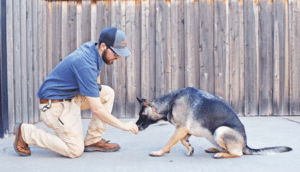
Some dogs will follow the treat straight to the floor and lie down the first time you lure, but most need a little lure/shaping here: move the treat down a little, mark and treat. Move it down a little more, mark and treat. Continue to lure him a little farther each time until he is all the way down.
If he stands up, you may have moved the lure too far, too fast, or moved it away from him rather than straight toward the floor and he got up to follow it. Try again, with smaller increments, and make sure the treat is moving straight toward the floor.
2. Add the cue. When your dog will lie down easily for the lure, it’s time to add the cue. Say “Down!” in a cheerful tone of voice (invitation, not command!), and lure him into a down position. Repeat this at least a half-dozen times. Continue to mark and give treats for downs throughout the process.
3. Add a pause. Now say “Down” in a happy voice and pause a few seconds. Make sure you have the treat in a neutral position at your side or behind your back. If you hold it up at your chest, you are giving your dog a body language signal to sit. Because dogs are primarily body language communicators, he will likely pay more attention to your “Sit” signal than your verbal “Down” cue.
If he lies down when you say the cue, mark and treat and party – you have a canine genius! More likely he won’t lie down for just the cue yet, so after two to three seconds, lure him to lie down, then mark and treat. Repeat several times.
4. Vary the pause. Continue to “Down”-pause-lure, but now start to vary how long you pause before luring. Sometimes lure after just a one-second pause, sometimes two to three seconds, and sometimes wait as long as five or six seconds.
5. Reinforce offered behaviors. Some dogs will begin to offer downs at this stage with the longer pauses. Mark and treat and party!
Continue to repeat this step, and remember that he may still need some luring. Just because he lies down in response to the cue without luring sometimes, doesn’t mean he fully understands. Repeat until he responds to your “Down” cue without the lure 80 to 90 percent of the time. Remember, it’s better to lure as needed than to repeat the cue and risk “learned irrelevance,” where the cue loses its meaning.
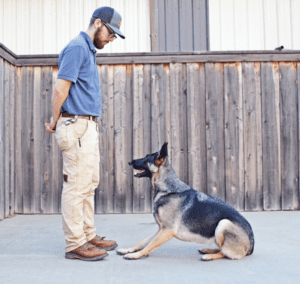
6. Fade the lure. If you have one of the many dogs who just doesn’t get it with the cue-pause-lure step, you will need to fade the lure.
Give him your cheerful “Down” cue, pause, and begin to lure. As soon as he appears to be committed to lying down, whisk the lure out of sight behind your back and let him finish the down without the lure in front of his nose. Mark and treat. Gradually lure less and less, whisking the treat out of sight sooner in the down sequence, until, lo and behold, you don’t have to lure at all. Mark, treat, and party!
Another Language
You can use this same process to put many different behaviors solidly on verbal cue. First get your dog to do the behavior, then add the cue, then fade the lure. It is very important to begin fading the lure as soon as he will reliably perform the behavior so that your dog and you don’t become dependent on the presence of the lure to make the behavior happen.
We are a verbal species, and while it is critically important for us to understand our dogs’ body language communications, there is something quite compelling about helping our non-verbal canines learn our language. It is very gratifying – and incredibly valuable for strengthening the dog-human bond – when your dog understands and responds to your verbal cues. Just decide what behavior you want on verbal cue, and get started!


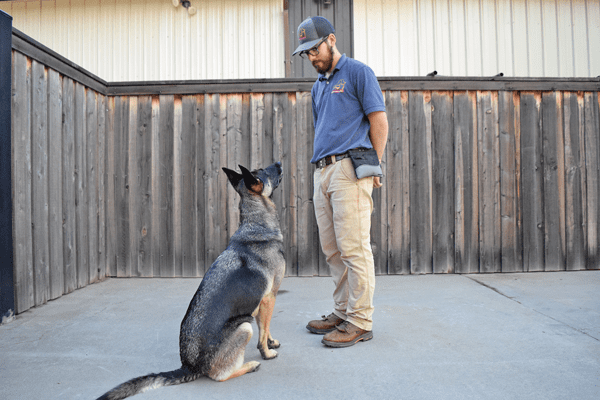
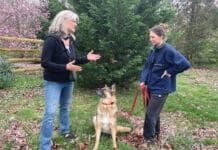



Excellent.
I think the average dog person uses way too many words, and the dog gets confused or tuned out. The person gets more frustrated and gets more wordy and energized which often makes the situation worse. I think people need to become more aware of their body language in respect to their dogs. We are always communicating with our body language/energy/focus and they are brilliant about reading us. Unfortunately the average person is very confusing to most dogs. If we learn about ourselves and how we come across to the dog then we will discover a whole new way of being in our lives.
My next challenge would be to get your dog to comply without any words, and without food, toys or devices and as subtle signals as possible. Test your true knowledge of a dogs most innate and basic communication of body language and energy. It is the purest, and, I find, deepest level of connection. When you can communicate with out human language then you are reaching the dog where they live – which feels pretty profound.
Great article.
My mother used to talk to the family dog constantly, and I’ve done the same with all three of my dogs. Behaviorally, they were all unique, but they all developed sizable vocabularies due to my constant chatter. Say any food-related word (anything from “chicken” to “hungry”), and my current dog, Charlie, snaps to attention.
I believe that dogs who understand the concept of language learn verbal commands very quickly — and food-related words seem to teach this. But, don’t give up on physical cues as well; as they get older and lose the ability to hear, those signals will be life-savers.
I have a wonderful (aren’t they all) Labrador Retriever. However, the “cue” COME is not in his vocabulary.
That is probably the only word he does not respond to. I can say “food -treat” and he is there on a dime.
But, COME does not elicit any response. Any suggestions. He is now 8 – but I think smart enough to keep learning.
Hi Anne,
The word “COME” may have become poisoned or diluted of meaning in his head.
Try to pick a different word and begin training exactly as the article says using a different word entirely…maybe use the French word for “Venez-ici” or another cue I use is “Front” which results in m,y dog coming to me and sitting immediately in front of me facing me.” (training this sequence takes a little more doing but if your dog is food motivated it helps.
Other RECALL words possibilities are:
“HERE” ….”ICI”….”ME”…..”RETURN”….or it could even be a nonsense word that only you know “popcorn.
The dog can learn to associate any word wioth the behaviour.